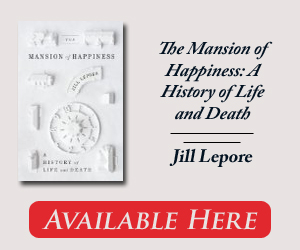
The Mansion Of Happiness: A History of Life and Death, By Jill Lepore, Knopf, 282 pp., $27.95
The arresting frontispiece of The Mansion of Happiness shows nine somber male figures standing on a Lebenstreppe, the “steps of life,” mounting decade by decade to age 50, then climbing down, increasingly decrepit, to age 90 and death. A motto inscribed beneath teaches: “Resist the Devil and he will fly far from you.” Few images of the stages of human life from childhood to old age are more evocative than the woodcuts and engravings, popular since the 1660s, depicting men, women, sometimes couples on such Lebenstreppen, wearing costumes and headgear of every kind according to sex and age. The illustrations were meant not only to inspire but also to instruct, sometimes through idealized images of each stage—playful children, idealistic youths, handsome young married couples, loving parents and grandparents, with the old accepting their inevitable fate—and at other times through caricatures, as of the swaggering stepwise ascent of young Napoleon followed by his ever more calamitous descent.
Jill Lepore, a Harvard historian and New Yorker staff writer, draws on essays first published in that magazine for a breezy, informative, wide-ranging book. True, it is hardly a history of life and death. But since such a history could contain just about anything, Lepore argues, she has chosen to tell particular stories, in chapters that “follow the stages of life or what used to be called the ages of man.” And even as the book’s frontispiece includes an infant in a cradle beneath the stairs at the left and a shrouded corpse at the right, so she has chapters on two extra stages of life: life before birth and the possibility of freezing bodies after death. In between “lie chapters on infant care, childhood, growing up, marrying, working, having kids, growing old, and dying.”
The introductory chapter piques the reader’s curiosity with an absorbing history of games—including one called The Mansion of Happiness, in which players enter life and follow its course—and of the men who created and marketed them. The Mansion of Happiness was introduced in England in 1800 and soon became popular in America. It was overtaken by Milton Bradley’s Checkered Game of Life, which begins in Infancy and ends for some but not all at Happy Old Age; there is no square called Death, though much can happen to interfere with happiness in old age, including Ruin, Poverty, Disgrace, and Suicide. These games, with their trials and tribulations, cut across the stages of life; more recent ones, such as the Game of Life, ignore death altogether—a fact Lepore offers in support of her view that with the arrival of new scientific narratives of human progress, “youth vanquished age, and death grew unthinkable.”
At times, the linkage between stages of life and the chapters devoted to them is tenuous indeed. For instance, the chapter on infant care turns out to focus on breastfeeding, and that on childcare takes up the history of rooms for children in American libraries. The chapter on growing up, “All About Erections,” centers on sex education, viewing adolescence as a stage of life invented in the early 20th century, when the word meant “the time between when you learn about sex and when you do it.”
In the process, however, each chapter brims with accounts of how particular issues of life and death have been debated and fought over. The first chapter, “Hatched,” begins with the worldwide sensation caused by the 1965 publication of the first-ever photos of a human fetus by Lennart Nilsson in Life magazine, then goes back in history to explore views regarding procreation, including the long-standing belief that human beings come from seeds, not eggs. The chapter concludes, after touching on the Hatchery in Huxley’s Brave New World, with Stanley Kubrick’s “story of the origins of man—without women”: 2001: A Space Odyssey.
Throughout, Lepore offers lively, carefully researched individual portraits: of Milton Bradley, who made a fortune from inventing and manufacturing the Checkered Game of Life, only to lose interest in games and turn, instead, to advocating free kindergarten education; of Margaret Sanger, the early advocate of birth control, who, after being indicted for violating obscenity laws, opened the first birth control clinic in the United States and founded Planned Parenthood; of her adversary Paul Popenoe, author of a long-running column in Ladies’ Home Journal (“Can This Marriage Be Saved?”) and a leader in the eugenics movement and the campaign to sterilize “the unfit”; and of Robert C. W. Ettinger, who founded the cryonics movement in this country and who spoke with Lepore about his hope to be frozen when he died, then stored in a vat of liquid nitrogen until scientists could defrost him and render him young once again.
With a historian’s eye, Lepore skillfully brings out the ways in which her subjects move through successive stages of life, examining the circumstances surrounding their births, their families, their educations, their working lives, sometimes their old age, and deaths. Through such life stories, she brings together the two cross-cutting themes in her book: that of the stages of life, and that of life as an often unpredictable game. In a similar manner, Joan Erikson designed a many-hued “Woven Life Cycle” to show how Erik Erikson’s eight cycles of life from birth to maturity (to which she, late in life, added a ninth) intersect with the tensions and challenges that individuals experience at each stage.
Lepore underscores the increasingly charged debates in the United States in recent decades about issues such as abortion, sex education in schools, end-of-life medical care, stem cell research, and the right to die. She views the shift to recast so many domestic policy issues as matters of life and death as having begun in 1965, when Life published the first photo of a fetus and the Supreme Court issued its ruling in Griswold v. Connecticut (invoking the right to privacy in overturning the state’s anticontraception law), and intensifying after 1975, with the publicity surrounding the case of Karen Ann Quinlan.
 The chapter on dying, “The Gate of Heaven,” contains a detailed account of Quinlan’s 1975 collapse, at 21, into a vegetative state, the court proceedings regarding her parents’ request to withdraw treatment, a final court ruling in their favor, and her living on even after she was removed from the ventilator until she died of pneumonia in 1985. The Quinlan case brought out debates about boundaries between life and death, the moral questions of what she might have wished done, who had the right to make choices for her, and the moral and legal debates about whether to cease her life support. Lepore vividly conveys the drama for family members, for reporters covering the court cases, and for the lawyers and judges involved. Looking at the decades of partisan debates over issues such as abortion, contraception, and more recently over “death panels” and “pulling the plug on grandma,” she concludes that a fundamental shift in American political culture has occurred, bringing about a newly configured political landscape: “Since the 1960s, what Americans were talking about, even when they seemed to be talking about something else, was a disputed right to life.”
The chapter on dying, “The Gate of Heaven,” contains a detailed account of Quinlan’s 1975 collapse, at 21, into a vegetative state, the court proceedings regarding her parents’ request to withdraw treatment, a final court ruling in their favor, and her living on even after she was removed from the ventilator until she died of pneumonia in 1985. The Quinlan case brought out debates about boundaries between life and death, the moral questions of what she might have wished done, who had the right to make choices for her, and the moral and legal debates about whether to cease her life support. Lepore vividly conveys the drama for family members, for reporters covering the court cases, and for the lawyers and judges involved. Looking at the decades of partisan debates over issues such as abortion, contraception, and more recently over “death panels” and “pulling the plug on grandma,” she concludes that a fundamental shift in American political culture has occurred, bringing about a newly configured political landscape: “Since the 1960s, what Americans were talking about, even when they seemed to be talking about something else, was a disputed right to life.”
Such a claim conveys Lepore’s singular, always stimulating perspective in what she rightly calls her book of stories, but it may well surprise readers who believe they have much else to talk about in life, not least when it comes to death and dying, quite apart from dramatic individual cases like that of Karen Ann Quinlan. In America as elsewhere, dialogues about how to deal with that last stage on the ladder of life concern far more than any disputed right to life, engaging families, communities, and societies in increasingly sophisticated, often empowering ways.

